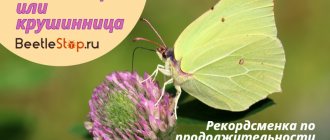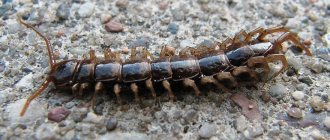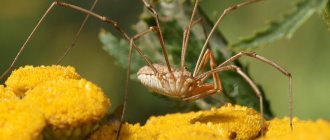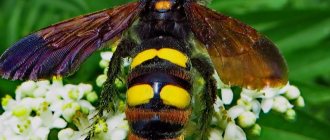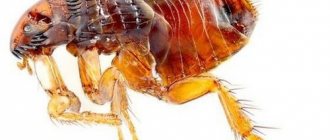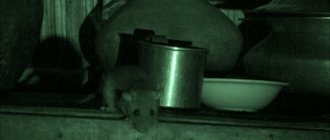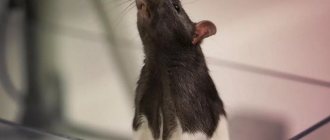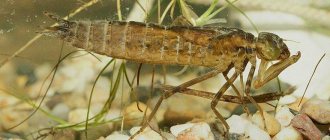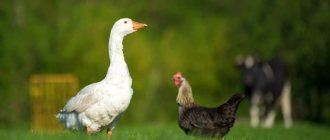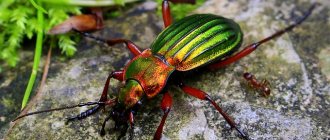Dragonflies are winged predators that captivate with their grace and beauty. They are one of the oldest amphibious insects that raise their offspring in an aquatic environment. The beautiful girl dragonfly is an amazing creature with a mother-of-pearl body and shiny wings. It is an excellent indicator of the cleanliness of a reservoir. If an insect has settled on its shore, then there is no chemical waste in the water.
Description
Length 45-48 mm, abdomen 34-38 mm, hind wing 30-31 mm, wingspan up to 70 mm. The male has no pterostigma. Body with a metallic sheen, blue with a green tint. The middle of the wing bears a wide metallic-shiny blue or dark blue band; the bases and apexes of the wing are colorless and transparent.
The female, instead of the pterostigma, has a light spot crossed by veins. The wings are almost colorless, with metallic shiny green cross-veins. The body is golden-green or bronze-green. The wings are relatively transparent, with a greenish tint and metallic shiny green cross-veins.
Features of reproduction
During the breeding season, females begin to circle above the water in search of a place to lay eggs. Noticing their reflection, the male begins courtship. The mating process occurs in a unique way - the male holds his partner with special anal appendages called the prothorax. The female places the genital opening to the second segment of the partner's abdomen. They remain in this intricate position for 5-10 minutes. Mating usually takes place on plants.
After fertilization, females lay 200-300 eggs on the stems of aquatic plants. At the same time, they not only land on the surface of the water, but also dive for a long time. Before diving, the beautiful girl wraps herself in an air bubble, so she can stay under water for about an hour. The female lays oblong eggs, descending along the stem of an aquatic plant, looking for cavities in it.
The larvae stay in places with weak currents, this allows them to better absorb oxygen. For breathing, at the end of the nymph's body there are three triangular-shaped gill plates. This organ regenerates after being attacked by predators or molting. The last stage of development ends on land. Nymphs emerge from the water, climb onto plant stems or driftwood, where they metamorphose into adults.
Dragonflies are an important part of the environment; reducing their numbers has a negative impact on the balance of nature.
Lifestyle
Adult beauties appear from May to September. In daylight they actively hunt, and at night they hide among plants. These dragonflies fly most readily on warm sunny days.
Males of beauties occupy home areas along the banks of reservoirs, and females often fly far from the water, appearing in whole flocks in places illuminated and well-warmed by the sun.
The beauty's flight is slow and uneven, but very maneuverable. She makes sharp turns, flies backwards and can even hover in one place like a helicopter. Deciding to rest, the dragonfly sits on a stalk or blade of grass. Its wings are folded with their upper planes inward or slanted back.
The beauty hunts insects in the air, grabbing them with the first pair of legs extended forward; its victims include all kinds of butterflies, beetles, flies, wasps and other dragonflies. The dragonfly often devours small prey on the fly, and deals with larger prey by sitting on some plant.
Dragonfly beauty girl
What kind of predator do you think is called the romantic name “beauty girl”? If you don’t know, you won’t guess! The dragonfly Calopteryx virgo, which belongs to the beauty family. It may be a little unusual to consider a dragonfly a predatory creature, but the fact remains: since its diet includes the larvae of other insects and fish eggs, it is a real predator.
What does it look like
This dragonfly is very small and reaches only 5 centimeters in length. The wingspan is also small - no more than 7 centimeters. She has a thin, graceful body and translucent wings. But its amazing color evokes admiration: bright blue-green with pearlescent tints in males and bronze-green in females.
Habitats
The beauty lives almost everywhere in Eurasia. It can be found even beyond the Arctic Circle. However, recently scientists began to sound the alarm after discovering a sharp decline in the number of the species in certain regions of Russia. For example, in the Kurgan region you hardly see beauties anymore. Environmentalists believe the reason for this is pollution of rivers and lakes. The species was listed in the Red Book of Russia.
The usual habitat of beauties is the banks of small bodies of water with calm or slowly flowing water: streams, rivers, lakes, and less often swamps. The main thing is that there is a lot of aquatic vegetation, because dragonflies lay eggs on the stems.
Lifestyle and reproduction
The beauty flies slowly, as if with a sense of self-esteem, making sweeping wings. She constantly flies from stem to stem, but is always careful - the slightest extraneous sound or shadow, she breaks down and flies away.
She has something to be afraid of, because there are so many birds around that feed on dragonflies, and her life is already short: from April to October. In a matter of months, the beauty needs to have time to fulfill its purpose - to lay eggs, of which there are 250-300 in a clutch.
The method that the dragonfly uses when laying is very interesting. Having chosen a smooth stalk of reed or kugi in the coastal thickets, she sits on it upside down and lowers herself into the water. Having reached a depth of about a meter, she finds a hole or crevice in the stem, where she lays her eggs. How does she breathe underwater? It’s very simple: when diving, it exhales air in a special way, as a result of which an air bubble forms around it. The oxygen supply in it is enough for about an hour and a half, and during this time the busy dragonfly manages to lay its eggs.
Both adult beetles and their larvae are very sensitive to water conditions. They can develop normally only in a clean environment rich in oxygen. That is why scientists call dragonflies of the family of beauties indicators of the cleanliness of water bodies.
The eggs of the beauty are incubated until next spring, after which larvae begin to develop in them. However, it will take another year or even two before they become the same beautiful creatures as their parents were! Each larva has microscopic thread-like gills at the tip of its body, with which it can breathe in water.
Other types of dragonflies:
Angelina Dragonfly Spotted Stonefly Dragonfly Watcher-Emperor
Grandfathers
Among the features of these dragonflies are the variegated coloration, widely spaced eyes and the presence of a notch at the base of the hind wings in males. Grandfathers are capable of long flights and prefer flowing reservoirs with clean water, where females lay eggs directly in flight.
Common dedka, tailed dedka and horned dedka are the most common species of dragonflies in Central Russia. These names sound funny (as well as “metal grandmother” or “bronze grandmother”), but you need to keep in mind that grandfathers are also called rivermen, and grandmothers – patrolmen. The Common Dedka is a black and yellow dragonfly with transparent wings. The coloring is vaguely reminiscent of wasp.
Dedok larvae are voracious, strong and can burrow into soft mud. And adult grandfathers, oddly enough, are short-lived. They live no longer than a month.
Notes
- Shcherbak G. Y., Tsarichkova D. B., Verves Yu. G. Zoology of spineless animals: handbook: Book. 2. - K.: Libid, 1996. - 320 p.
- Shvanvich B.N. Course of general entomology: Introduction to the study of the structure and functions of the body of insects (Textbook for state universities) - M.-L.: “Sovetsk. science", 1949. - 900 s
- Bondarenko N.V., Polyakov I.Ya., Strelkov A.A. Harmful nematodes, mites, rodents. – L.: branch of the publishing house “Kolos”, 1969. – 272 p.
- Zakhvatkin Yu.A. Acarology - the science of ticks: History of development. Current state. Systematics: Textbook. - M.: Book house "LIBROKOM", 2012. - 192 p.
- Skvortsov V. E.
Dragonflies of Eastern Europe and the Caucasus: Key Atlas. - M.: Partnership of Scientific Publications KMK, 2010. - 624 p. — 1000 copies. — ISBN 978-5-87317-657-1. - ↑ Popova A. N.
Larvae of dragonflies of the fauna of the USSR (Odonata). — Keys to the fauna of the USSR, published by the Zoological Institute of the USSR Academy of Sciences. Issue 50. - M.-L.: Publishing House of the USSR Academy of Sciences, 1953. - P. 9-52. — 236 p. — 1500 copies. - Raikov B. E., Rimsky-Korsakov M. N.
Zoological excursions. - 6th. - L.: Uchpedgiz, 1956. - 694 p. - ↑ Kutikova L. A., Starobogatov Ya. I. (ed.).
Key to freshwater invertebrates of the European part of the USSR. - L.: Gidrometeoizdat, 1977. - P. 266-268. — 513 p. - Marlatt C. F. (1907). "The periodical cicada". Bulletin of the USDA Bureau of Entomology. 71:1-181
- Life of animals. Volume 3. Arthropods: trilobites, chelicerates, trachea-breathers. Onychophora / ed. M. S. Gilyarova, F. N. Pravdina, ch. ed. V. E. Sokolov. — 2nd ed. - M.: Education, 1984. - P. 215. - 463 p.
Tatyana Mityushina
Next in the selection of the most beautiful Russian girls is a Perm fashion model born in 1993. She won the hearts of viewers by starring in the Sports Illustrated Swimsuit Issue. The main theme of the magazine is the publication of fashion models in swimsuits against the backdrop of an exotic landscape. They say that an appearance in this publication guarantees the lucky girl the status of a supermodel in the future.
Whether this is true or not is still unclear; but so far Tatyana’s credits include filming in Victoria’s Secret and Intimissimi. And another sensation made in 2022 in Los Angeles. Then Tatyana appeared at the premiere of the film “John Wick 2” in an outfit with no underwear underneath. Thanks to this, the paparazzi were able to easily capture Mityushina’s bare breasts.
SR Raffia Dragonfly Nymph
Hook: with a long shank, 2X - 4X, No. 8 - 10, in this case - TMS 200R No. 8
Mounting thread: brown, No. 6/0
Loading: thin lead tape or lead wire
Body and breast lining: mounting thread
Abdomen: raffia light or dark brown, depending on the natural color of the simulated larva
Legs: three pairs of hunting pheasant tail feather barbs glued together with mounting varnish or synthetic glue, natural coloring. There are three feather barbs on each leg. The joints are simulated by tying knots or bending the future leg with heated tweezers, followed by fixation with a drop of elastic varnish such as Dave's Flexament
Eyes: a piece of thick (0.5 - 0.8 mm) fishing line melted on both sides
Breast, head, wing rudiments: raffia light or dark brown, depending on the natural color of the simulated larva
Comment: all elements of the fly, made of raffia, require impregnation with elastic varnish. I prefer Dave's Flexament or Aquatex.
Variopterans and Anisozygoptera
The second suborder is heteroptera. They have a powerful body, and the base of the hind wings is widened. The eyes often touch. The flight speed of heteroptera is high. At rest, the wings of these dragonflies are spread apart. The larvae of dragonflies live in mud and breathe using rectal gills. It is worth mentioning some species of dragonflies belonging to heteroptera. This is an ordinary grandfather, a large rocker, a bronze headstock, and a blood dragonfly.
Representatives of the third suborder (Anisozygoptera) combine the characteristics of the first two, although in appearance they are closer to heteroptera. These dragonflies do not live in Russia.
Reflections in the water
Some of the most beautiful landscapes of nature are reflections in water . The world that opens up to us on the surface of the water has completely different boundaries than the real one. Blurry and surreal , it inspires us with deep philosophical thoughts, and simply gives us an unforgettable feeling of beauty, often complementing what we do not see in the real world...
|
|
| ||
updated 11.12.2012
It just so happens that this is the second winter I’ve been returning to this page. This time I invite readers of the green pages to once again plunge into summer with the wonderful paintings of Claude Monet and take a short trip to France
This time I invite readers of the green pages to once again plunge into summer with the wonderful paintings of Claude Monet and take a short trip to France
